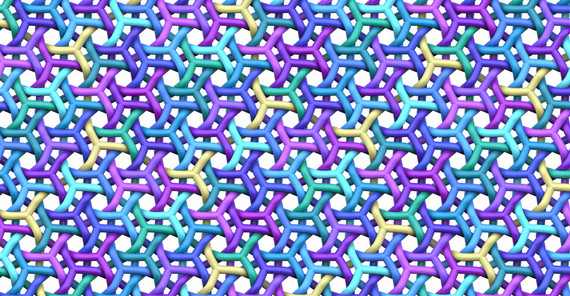We can ask the question: How does one tangle honeycomb networks together into a symmetric pattern? As an example, the structure shown in the image has 13 networks tangled together in a highly symmetric way. This is a question of interest to both mathematicians and synthetic chemists alike, used in the design and understanding of chemical frameworks, and as curious mathematical objects. In a recent paper, we studied this question using a constructive mathematical technique based on graph theory, low-dimensional topology and geometry. What we found was the enumeration of various highly symmetric entangled structures, with component numbers ranging from 1, 2, 3, 4, 6, 7, 9, 12, 13, and so on. We are even presenting an infinite series of structures with increasing numbers of networks tangled together, which in theory gives a method for the entanglement of infinitely many honeycomb networks together.
One can think of symmetry as a convenient route to building complex objects with relatively simple building blocks: make many of the small asymmetric patches, and then piece them together to form a large repeating pattern. This idea is employed by nature in structures such as virus shells, and in the lab in synthetic chemistry. Such a study here applies this idea of efficient design to the symmetry of how structures are tangled together, with possible ramifications in the design of microstructures materials.
This text was published in the university magazine Portal Wissen - Eins 2024 „Bildung:digital“ (PDF).

